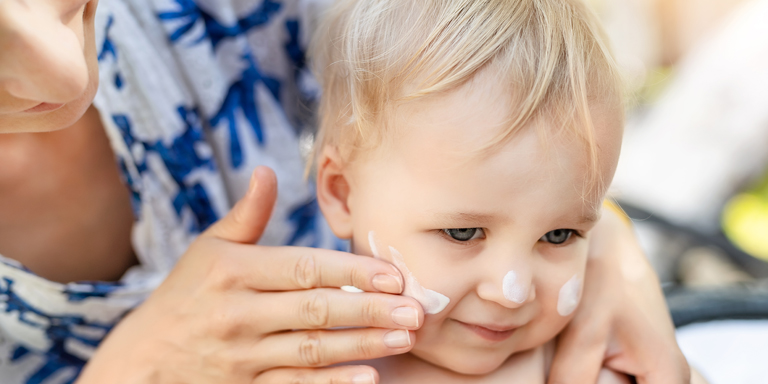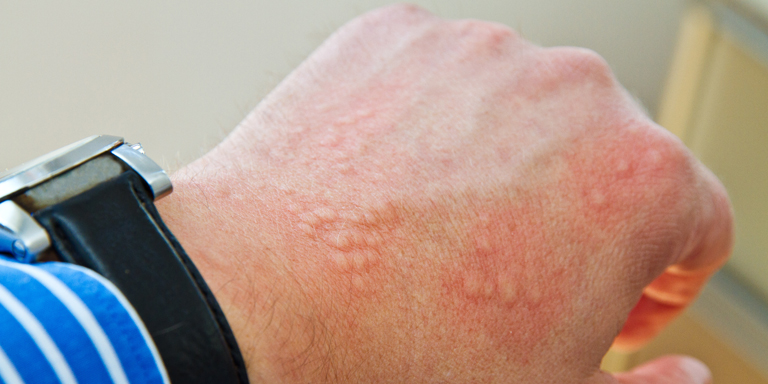Sun allergy
One day in the sun and the skin turns red, itches and develops a rash - despite the use of sun cream. What is happening? Could it be a sun allergy?

Table of contents:
Skin reactions on exposure to the sun are commonly known as sun allergy. In most cases, however, they are not an allergic reaction but are due to a separate disease.
The by far most common form of skin reaction to the sun is polymorphous light eruption. Other diseases that may occur are: Mallorca acne, phototoxic reaction, photoallergic reaction and light urticaria.
Polymorphous light eruption
Cause
This skin reaction is caused by unusually high UVA radiation. The exact mechanism of action is still unclear. It is estimated that 10 to 20% of the Central European population react with polymorphous light eruption on excessive exposure to the sun.
Risk groups
Polymorphous light eruption often affects light-skinned people; in our part of the world, it is more common in women. Other groups that are more susceptible include people with combination skin or dry skin. Polymorphous light eruption can manifest at any age.
Symptoms
Symptoms usually appear within 24-48 hours of intense exposure to sun radiation. Only the parts of the body exposed to the sun are affected, such as the lower neckline area, shoulders and nape of the neck. The first symptom is often red patches of skin with itching. But the symptoms are typically varied, hence the name polymorphous:
- itching
- red patches of skin
- small bumps and blisters
- swelling of the skin
The symptoms disappear spontaneously after a few days if the skin is no longer exposed to the sun.
Treatment
The most important preventive measure is to avoid the sun or wear appropriate sun protection: long trousers, long sleeves and a hat as well as sunscreen with a sufficiently high sun protection factor (SPF) of at least 30. If the skin has already reacted, the affected area of skin can be treated with cortisone creams or lotions and with zinc shake lotions. In most cases, the rash abates by itself when the sun is avoided. The disease generally has a chronic course, in each case following intense exposure to the sun. Over time, many of those affected grow more accustomed to the sun’s rays and so can gradually tolerate more exposure to the sun.
Mallorca acne (acne aestivalis)
Cause
As the name suggests, the disease looks like the acne that commonly occurs in adolescence. Mallorca acne develops as a result of the interaction between fatty sunscreen, the body’s sebum and UVA radiation. The most common triggers are emulsifiers. Young people with rather greasy skin are affected most.
Symptoms
The papules primarily appear in more oily (seborrheic) skin areas, such as the lower neckline area, the arms, shoulders, nape of the neck and the back. Sometimes there is also intense itching. The skin changes commonly occur in the spring and summer months and then spontaneously abate after a few weeks or months, without any scarring. The symptoms can chronically recur.
Treatment
Prevention involves avoiding the sun as much as possible and foregoing the use of oily sunscreen. Fat and emulsifier-free sunscreen products in gel form with high UVA and UVB sun protection are ideal. Antihistamines and exfoliating products for acne may also be used to treat the condition.
Phototoxic and photoallergic reactions
Interactions with other substances (e.g. medication).
Cause
Two less common forms of skin reaction following exposure to the sun are phototoxic and photoallergic reactions.
Phototoxic reaction
In a phototoxic reaction, chemical and natural compounds in medication, perfumes and cosmetics interact with the skin cells under the influence of the sun’s UV rays. Free radicals develop that damage the skin. The juice of certain plants, such as giant hogweed, angelica, fig trees, citrus fruits, St. John’s wort, bergamot and celery, can especially trigger this form of reaction.
Photoallergic reaction
In a photoallergic reaction, it is not the sun itself that triggers the allergy but a substance that enters the skin from inside or outside the body and that changes in structure on exposure to the sun. This may be an ingredient in a care product or drug, for example. Under the influence of UV radiation, the initially harmless substance develops into an allergen that is attacked by the immune system.
The following drugs can have a photosensitising effect: antibiotics, neuroleptics, antipsychotics, diuretics and anti-depressants. A photocontact allergy is life-long.
Symptoms
Phototoxic reaction
The skin reacts with itching, burning pain, redness and blistering - similar to sunburn. If the sun is avoided, the symptoms rapidly abate. Once the blisters heal, there may be marked pigmentation.
Photoallergic reaction
Symptoms are similar to those of a phototoxic reaction, and thus it is often hard to distinguish between the two forms. The symptoms abate only slowly even when the sun is avoided.
Treatment
With photoallergic and phototoxic reactions, avoiding the trigger substance is essential. Any perfumed medication and cosmetics with a phototoxic action should be avoided. Only fragrance-free sun protection should be used. In the case of phototoxic reactions, any contact with the plant triggering the reaction should be strictly avoided.
As well as avoiding exposure to the sun, cortisone ointments can soothe any skin areas that have changed. Cold compresses also help minimise the symptoms.
Light urticaria
Cause
Light urticaria, or solar urticaria, is a special form of urticaria (hives). It is triggered by light, especially sunlight. The typical symptoms are caused by the release of histamine in the cells.
Symptoms
Weals appear within minutes of exposure to the sun, usually with erythema. These swellings in the upper skin layer measure a few millimetres to a few centimetres and often occur with intense itching, which is aggravated by scratching. The weals usually disappear again after a few hours.
Treatment
Treatment primarily involves the use of sunscreen and adherence to general light protection measures (see prevention below). Antihistamines may also help.
Diagnosis
The form of light dermatosis is determined based on the medical history. If a chemical trigger (e.g. medication, cosmetics etc.) is suspected, this can also be confirmed with a photo patch test or using photo provocation, i.e. involving ingestion of the suspected trigger and irradiation of the skin with sunlight.
Prevention
Ensure you take the following measures:
- apply a physical sunscreen with a high sun protection factor (SPF) in the UVA and UVB range of at least 30 or above before leaving the house. Also protect the lips with a specifically designed product.
- avoid long and direct exposure to the sun. It is advisable to stay in the shade. Do not forget: snow, sand and water reflect the sun’s rays.
- allow the skin to slowly become accustomed to UV radiation in the spring and summer months. Increase exposure to the sun only gradually.
- avoid the midday sun completely from 11:00 am to 3:00 pm.
- ideally wear light clothing made from natural fibres such as cotton or linen. There is also clothing with special UV protection.
- protect the head with a sunhat with a sufficiently wide brim. Baseball caps are not ideal, as shown in several studies.
- wear sunglasses with UV protection.
- Avoid using any perfume, scented aftershave or lotions with a high fat content before sunbathing.
- if taking any medication over a prolonged period: ask the doctor about possible interactions, check the package leaflet or ask at the pharmacy.
Useful facts
- Difference between UVA and UVB: UVA penetrates the skin deeper and is responsible for pigment spots, skin ageing and wrinkles. UVB acts on the upper skin layers and is responsible for sunburn, burns and most types of skin cancer.
- Window glass only protects against UVB radiation, but not against UVA light.
- wet, tightly fitting clothing provides little UV protection.
- natural cosmetic products may contain plant ingredients that may cause a phototoxic reaction.
Editors: aha! Swiss Allergy Centre in co-operation with the Scientific Advisory Board.




